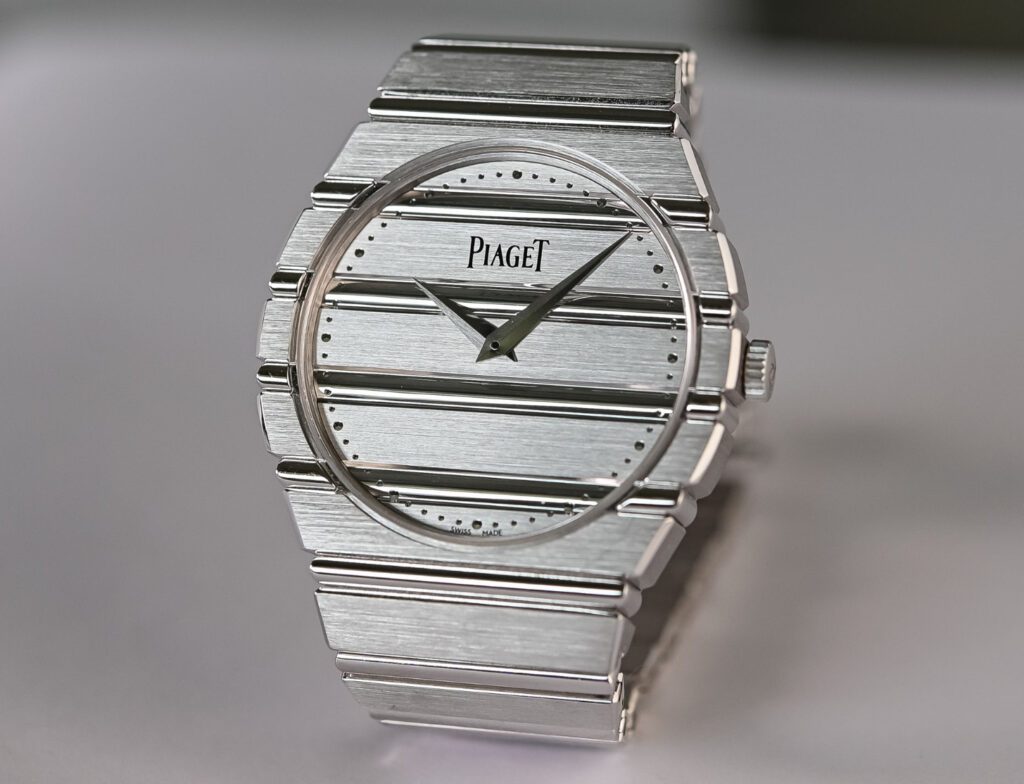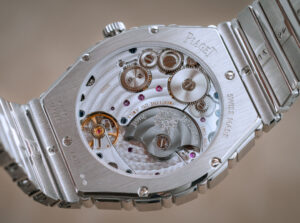In an era increasingly defined by ephemeral trends and hyper-accelerated design cycles, there is a peculiar, almost rebellious power in restraint. Piaget, the Swiss Maison that has long defined the nexus of elegance and technical prowess, asserts this truth yet again with the release of the Piaget Polo 79 in white gold. At once audacious and restrained, extravagant and refined, the Polo 79 is not merely a revival but a resounding statement about the enduring resonance of craftsmanship and heritage.
Reviving an icon from a golden age without succumbing to mere nostalgia is a delicate art. For Piaget, it has meant harnessing the house’s signature language—the gadroon motifs, the seamless bracelet-to-case transition, the whisper-thin movement—and amplifying it in a way that feels both faithful and freshly provocative. The Piaget Polo 79 in white gold is a study in contrasts: it is simultaneously a tribute and a testament, a return and an evolution.
Origins of an Icon: The 1979 Piaget Polo
To understand the significance of the Polo 79’s reintroduction, it is important to understand what the original Polo represented in 1979. In a world growing infatuated with sport-luxury watches—the kind that could slide under a cuff at a gala but survive a polo match afterward—Piaget’s answer was not to borrow from its competitors but to invent anew.
The original Polo was born of the same creative soil that nourished the legendary Piaget cuff watches and secret watches of the ’60s and ’70s: a world where watches were jewelry first, timepieces second. The Polo, with its soft, integrated silhouette and buttery transition from case to bracelet, declared that luxury was no longer a stiff formalism but an expression of fluidity and ease. Yves Piaget himself summed it up best: the Polo was designed to be worn “in the morning while playing polo and in the evening at a party.”
No wonder then, that the original became a darling among the jet set. It graced the wrists of luminaries from Brooke Shields to Andy Warhol, embedding itself in an era where understated opulence was the highest form of taste.
The White Gold Rebirth: A Celebration of Enduring Codes
The new Piaget Polo 79 in white gold is at once recognizable and revelatory. From a distance, it telegraphs its lineage with absolute clarity: the signature gadroon motif running uninterrupted across the bracelet and dial, the ultra-thin profile that defies the laws of physics, the discreet crown almost swallowed into the side of the case.
But a closer examination reveals a piece that has matured—one that speaks to today’s collectors with a language sharpened by decades of design evolution.
Firstly, the material itself is a statement. By crafting the watch entirely in white gold, Piaget has doubled down on the idea that true luxury is in texture, in weight, in the feel of a watch against the skin. White gold carries a muted brilliance that yellow gold cannot replicate; it is softer to the eye yet heavier to the hand, offering a tactile gravitas that is intimate and unmistakable.
The proportions are carefully refined. The case measures a contemporary 38mm—sized to feel assertive without shouting, fitting for both traditionalists and modernists alike. The gadroons, those elegant ridges that ripple across the piece, are sharper yet more nuanced, catching the light with a crispness that speaks to advancements in finishing techniques that Piaget has perfected over decades.
Seamlessness as Philosophy: The Bracelet and Case
Perhaps the most seductive element of the Polo 79 has always been the way its bracelet and case are indistinguishable. This seamlessness is not just aesthetic but philosophical. Piaget has always understood that the highest luxury is not in ornamental extravagance but in the removal of all boundaries between form and function.
In the new Polo 79, the bracelet is a marvel: each link precisely calibrated so that it appears as a single, fluid entity. Whether draping over the wrist or glinting under a cuff, it communicates something rare—movement and stillness coexisting in metal.
Unlike many modern sports watches that lean into angularity and visible construction, the Polo 79 erases the divisions between components. It doesn’t flaunt its architecture; it whispers it. And in that whisper is a powerful seduction.
The Heart Within: The Ultra-Thin 1200P1 Movement
Inside the white gold case beats the Piaget Manufacture 1200P1 movement, a mechanical automatic calibre that measures a mere 2.35mm in thickness—a staggering technical achievement that reinforces Piaget’s standing as a master of ultra-thin watchmaking.
The 1200P1 is not just thin; it is beautiful. Its micro-rotor design allows the movement to retain mechanical robustness while achieving its svelte profile. Bridges are decorated with circular Côtes de Genève, screws are blued, and the micro-rotor itself is engraved with the Piaget coat of arms—a touch visible only to the few who will ever peer into the movement, but there nonetheless, because real luxury does not compromise.
Despite its thinness, the movement delivers a 44-hour power reserve, a testament to Piaget’s quiet technical leadership—a legacy that too often remains overshadowed by its aesthetic daring.
Extravagance and Refinement: A New Lexicon
The language Piaget speaks with the Polo 79 is one of dualities, balancing extravagance and refinement with a deftness few can match.
In lesser hands, a full white gold watch with an integrated bracelet and heavily polished surfaces could tip into ostentation. Piaget’s genius lies in its ability to sidestep vulgarity entirely. The Polo 79 wears its extravagance like a well-tailored tuxedo: visible, unmistakable, but always tasteful.
It is not a tool watch, not a performance instrument. It is a declaration of a life where time itself bends to pleasure—a relic from a world where the greatest luxury was freedom.
A Mirror of Cultural Evolution
The reintroduction of the Polo 79 also serves as a fascinating cultural artifact. When the original Polo emerged in 1979, the global mood was shifting. The oil crisis had begun to wane, disco fever was peaking, and a new class of transnational wealth was taking shape. The Polo spoke to a sensibility that embraced hedonism without guilt, that celebrated the blur between sport and society, leisure and work.
Today, in an era obsessed with optimization and minimalism, the Polo 79 feels almost radical. It asks a provocative question: What if you wore something simply because it was beautiful? What if pleasure, rather than function, were your primary guide?
In that sense, the Polo 79 is not just a watch; it is an antidote. It offers a counter-narrative to the asceticism of today’s wearable tech, reminding us that true elegance often lies in the superfluous—the unapologetically beautiful.
Why It Matters
The importance of the Piaget Polo 79 goes beyond mere aesthetics or even horology. It reasserts the value of human touch in a world increasingly dominated by algorithmic taste-making. Every gadroon, every polished surface, every sweep of the bracelet across the wrist tells the story of human hands coaxing artistry out of inert material.
Moreover, it represents a quiet but firm rejection of the utilitarianism that has crept even into the luxury sector. In a world where even high-end watches are marketed with vague allusions to “adventure” and “performance metrics,” the Polo 79 dares to say: This is for the joy of it.
And that is no small thing.
Piaget has always danced to its own rhythm, and the Polo 79 in white gold is a perfect encapsulation of that spirit. In its seamless construction, its whisper-thin mechanics, and its unapologetic devotion to beauty, it represents not just a continuation of legacy but an affirmation of values that feel increasingly rare.
Wearing the Polo 79 is not about marking time. It is about inhabiting time differently. It is about giving yourself permission to live a little more artfully, to approach each day with a little more ceremony.
And perhaps most importantly, it reminds us that some things—beauty, craftsmanship, joy—are worth carrying forward, even into a world that seems increasingly determined to leave them behind.
In white gold, the Piaget Polo 79 does not merely endure. It gleams.
No comments yet.









